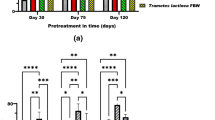Abstract
Few detailed studies have been made of the relative rates of removal of the structural components of wood (cellulose, hemicelluloses, and lignin) during decay by white-rot fungi. Kretsberg et al. (1971) showed that the total pentosans are destroyed faster than the cellulose, and the lignin more slowly than cellulose or pentosans, during the decay of spruce by the white-rot fungus Trametes trogii. Kirk and Highley (1973) found that the relative rates of removal of lignin and the other components by three white-rot fungi in conifer woods decayed in soil-block tests varied during the decay process. Their results suggested that removal of glucomannan may precede removal of cellulose as found in brown-rots, but that additional wood and fungus combinations are needed before it can be established whether this is a valid generalization for white-rots. For hardwoods, such detailed analysis seem to have been done only by Cowling (1961) who found that Coriolus versicolor removed lignin and carbohydrates at about the same rate in sweetgum. Removal of glucan, mannan, and xylan, however, was not determined until 25% weight loss.
The Forest Products Laboratory is maintained in cooperation with the University of Wisconsin. This article was written and prepared by U.S. Government employees on official time, and it is therefore in the public domain and not subject to copyright.
Access this chapter
Tax calculation will be finalised at checkout
Purchases are for personal use only
Preview
Unable to display preview. Download preview PDF.
Similar content being viewed by others
References
American Society for Testing and Materials. (1971). Standard method for accelerated laboratory test of natural decay resistance of woods. ASTM D 2017. Philadelphia, PA
Blanchette, R. A., Otjen, L. Effland, M. J., and Eslyn, W. E. (1985). Changes in structural and chemical components of wood delignified by fungi. Wood Sci. Technol., 19, 35–46.
Cowling, E. B. (1961). Comparative biochemistry of the decay of sweetgum sapwood by white-rot and brown-rot fungi. USDA Tech. Bull. 1925, 79 pp.
Darbyshire, B., Wade, G. C., and Marshall, K. C. (1969). In virto studies of the role of nitrogen and sugars on the susceptibility of apple wood to decay by Trametes versicolor. Phytopathol. 59(1), 98–102.
Dill, I. and Kraepelin, G. (1986). Palo podrido: Model for extensive delignification of wood by Ganoderma applanation. Appl. Environ. Microbiol. 52(16), 1305–1312.
Effland, M. J. (1977). Modified procedure to determine acid-insoluble lignin in wood and pulp. Tappi 60(10), 143–144.
Ericksson, K.-E. (1978). Enzyme mechanisms involved in cellulose hydrolysis by the rot fungus Sporotrichum pulverulentum. Biotech. Bioeng. XX, 317–332.
Ericksson, K.-E. and Goodell, B. (1974). Pleiotropic mutants of the wood-rotting fungus Polyporus adustus lacking cellulase, mannanase and xylanase. Can. J. Microbiol. 20, 371–378.
Highley, T. L. (1973a). Effect of alkaline treatment on decay resistance of wood. Forest Prod. J. 23, 47–51.
Highley, T. L. (1973b). Influence of carbon source on cellulase activity of white-rot and brown-rot fungi. Wood Fiber. 5(1), 50–58.
Highley, T. L. (1976). Hemicellulase of white-and brown-rot fungi in relation to host preferences. Mat. und Org. 11(1), 33–46.
Highley, T. L. (1982). Influence of type and amount of lignin on decay by Coriolus versicolor. Can. J. For. Res. 12, 435–438.
Highley, T. L. (1987). Change in Chemical components of hardwood and softwood by brown-rot fungi. Mat. und Org. 22(1), 39–45.
Kelly, R. C, and Reddy, C. A. (1986). Identification of glucose oxidase activity as the primary source of hydrogen peroxide production in ligninolytic cultures of Phanerochaete chrysosporium. Arch. of Microbiol. 144(31), 248–253.
Kirk, T. K., and Highley, T. L. (1973). Quantitative changes in structural components of conifer woods during decay by white-and brown-rot fungi. Phytopathol. 63, 1338–1342.
Kirk, T. K. and Moore, W. E. (1972) Removing lignin from wood with white-rot fungi and digestiblity of resulting wood. Wood Fiber. 4, 72–79.
Kirk, T. K., Schultz, E., Lorenz, L. F., and Zeikus, J. G. (1978). Influence of culture parameters on lignin metabolism by Phanerochaete chrysosporium. Arch. Microbiol. 117, 277–285.
Kretsberg, Z. N., Sengeeva, V. N., and Grabovski, Ya. K. (1971). Investigation of wood destroyed by enzymes. IV. The effect of Trametes trogii on spruce wood. (In Russian). Khim. Drev. 7, 115–118.
Levi, M. P. and Cowling, E. B. (1969). Role of nitrogen in wood deterioration. VII. Physiological adaptation of wood-destroying and other fungi to substrate deficient in nitrogen. Phytopathol. 59, 460–468.
Moore, W.E. and Johnson, D.B. (1967). Procedure for the chemical chemical analysis of wood and wood products (as used at the U.S. For. Prod. Lab.). USDA For. Serv., Madison, WI.
Park, D. (1976). Nitrogen level and cellulose decomposition by fungi. Int. Biodetn. Bull. 12(3), 95–99.
Petterson, C. A. and Cowling, B. (1964). Decay resistance of extractive free coniferous woods to white-rot fungi. Phytopathol. 54, 542–547.
Petterson, R. C, Schwandt, V. H., and Effland, M. J. (1984). An analyses of the wood sugar assay using HPLC: A comparison with paper chromatography. J. Chromat. Sci. 22, 478–484.
Reid, I. D. (1983). Effects of nitrogen sources on cellulose and synthetic lignin degradation by Phanerochaete chrysosporium. Appl. Environ. Microbiol. 45, 830–837.
Springer, E. L. (1966). Hydrolysis of aspen wood xylan with aqueous solutions of hydrochloric acid. Tappi 49, 102–106.
Timmeil, T. (1967). Recent progress in the chemistry of wood hemicelluloses. Wood Sci. Technol. 1, 45–70.
Author information
Authors and Affiliations
Editor information
Editors and Affiliations
Rights and permissions
Copyright information
© 1990 Springer Science+Business Media New York
About this chapter
Cite this chapter
Highley, T.L., Illman, B.L. (1990). Changes in Cell Wall Components of White Pine and Maple by White-Rot Fungi. In: Llewellyn, G.C., O’Rear, C.E. (eds) Biodeterioration Research. Biodeterioration Research, vol 3. Springer, Boston, MA. https://doi.org/10.1007/978-1-4757-9453-3_28
Download citation
DOI: https://doi.org/10.1007/978-1-4757-9453-3_28
Publisher Name: Springer, Boston, MA
Print ISBN: 978-1-4757-9455-7
Online ISBN: 978-1-4757-9453-3
eBook Packages: Springer Book Archive




